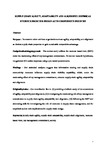Supply chain agility, adaptability and alignment: empirical evidence from the Indian auto components industry

Date
2018-01-02Author
Subject
Metadata
Show full item recordAbstract
<jats:sec><jats:title content-type="abstract-subheading">Purpose</jats:title><jats:p>The purpose of this paper is to examine when and how organizations create agility, adaptability, and alignment as distinct supply chain properties to gain sustainable competitive advantage.</jats:p></jats:sec><jats:sec><jats:title content-type="abstract-subheading">Design/methodology/approach</jats:title><jats:p>The current study utilizes the resource-based view (RBV) under the moderating effect of top management commitment (TMC). To test the research hypotheses, the authors gathered 351 usable responses using a pre-tested questionnaire.</jats:p></jats:sec><jats:sec><jats:title content-type="abstract-subheading">Findings</jats:title><jats:p>The statistical analyses suggest that information sharing and supply chain connectivity resources influence supply chain visibility capability, which, under the moderating effect of TMC, enhance supply chain agility, adaptability, and alignment (SCAAA).</jats:p></jats:sec><jats:sec><jats:title content-type="abstract-subheading">Originality/value</jats:title><jats:p>The contribution lies in: providing a holistic study of the antecedents of agility, adaptability, and alignment; investigating the moderating role of TMC on SCAAA; following the RBV and addressing calls for investigating the role of resources in supply chain management, and for empirical studies with implications for supply chain design.</jats:p></jats:sec>
Collections
Publisher
Journal
Volume
Issue
Pagination
Recommended, similar items
The following license files are associated with this item:

